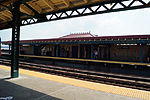Sherman Creek Generating Station
Consolidated EdisonFormer coal-fired power stations in the United StatesFormer power stations in New York CityUnited States power station stubs
The Sherman Creek Generating Station was a coal-fired power plant built by the United Electric Light and Power Company in New York City, on Manhattan Island at 201st Street and the Harlem River. The station supplied power to many customers, including the New York, New Haven and Hartford Railroad via the West Farms Substation. The station site was bounded by 201st Street to the north, the Harlem River to the East, and Sherman Creek to the South. United Electric Light and Power was later absorbed into Consolidated Edison, and the station was demolished. The site is now occupied by an enclosed ConEd substation. Aerial photo (says 1951)
Excerpt from the Wikipedia article Sherman Creek Generating Station (License: CC BY-SA 3.0, Authors).Sherman Creek Generating Station
West 201st Street, New York Manhattan
Geographical coordinates (GPS) Address Nearby Places Show on map
Geographical coordinates (GPS)
| Latitude | Longitude |
|---|---|
| N 40.8594 ° | E -73.9198 ° |
Address
West 201st Street 300
10040 New York, Manhattan
New York, United States
Open on Google Maps









